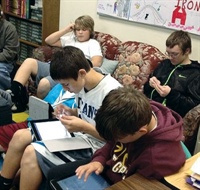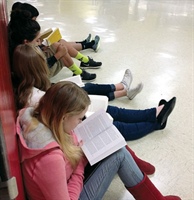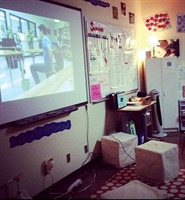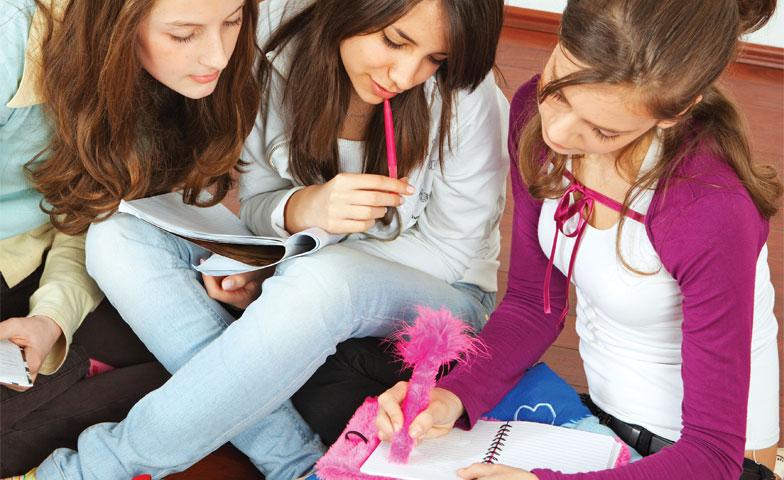“Class is over? Wow, that went fast!” That’s one of the biggest compliments a teacher can get. It means our students were engaged in their work.
Research shows that the average young adolescent’s attention span is between 8 and 14 minutes. If that’s the case, teachers who are trying to hold their students’ attention for the full 50–60 minutes may never hear students exclaim that “time really flew by.”

Comfortable classroom spaces help students engage in their learning.
At Neil Armstrong Middle School in Forest Grove, Oregon, I am constantly thinking about how I can make sure my English Language Arts content is relevant and my students are mastering standards and engaged in their learning. So two years ago, I flipped my classroom. In most flipped classrooms, some class time is spent discussing the previous night’s homework before students move into the application of knowledge with one-on-one teacher interaction. I added a mini-lesson between the discussion and the application to keep my students engaged. Our class time looks like this:
1. 5-Minute Vocabulary Activity
For the first five minutes of class, students work on a vocabulary game called Vocab SWAG developed by the ELA department. (Nerdy teacher alert: SWAG stands for Student Word Acquisition Game). The students define a group of words that are relevant to the units they are studying in their team’s classes (math, science, social studies, and language arts). They learn all the words in the group but choose a specific word to use as often as possible in conversations with their peers, teachers, and parents, and earn points for their efforts. This is a fun way to get the students to access new vocabulary.
2. 15-Minute Mini-Lessons

Sometimes students work better outside the classroom.
The mini-lessons change daily, but follow a basic structure for my content area.
Monday: Students do a journal write inspired by the book The Encyclopedia of an Ordinary Life by Amy Krouse Rosenthal.
Tuesday: We work on grammar. The specifics vary, depending on what unit we are working on and what the formative data tell me the students need. I use the grammar skills website www.noredink.com when I don’t have something specific planned.
Wednesday: It’s test prep day. In preparation for the new Smarter Balanced assessments coming out for the Common Core State Standards, we focus on skills that the students will need to be successful. For example, one item on the sample tests involves listening to podcasts and answering related questions. The podcasts we create are specific to our current unit of study and are short enough for students to complete in the 15-minute time frame.
Thursday: Students do a timed writing prompt within the construct of our current unit. If we are working on persuasive writing, it is a persuasive prompt. If we are working on identifying themes, I might ask students to read a short passage and then write about the theme.
Friday: I like to switch between mini-debates and analysis of poems to keep it fresh.
3. Core Content Work
After the mini-lesson, we transition into our core work, where students focus on mastering standards in preparation for upcoming assessments.
More Tips and Tricks

The Genius Bar and Charging Station is popular in this 1:1 school.
We know that middle school students thrive on attention, both positive and negative. It helps to use personal stories, humor, fair treatment, and proactive discipline to create an effective learning environment. Keep your room, your activities, and your stories relevant. Nothing throws a middle school student off track faster than something that they can easily check out of because they can’t relate. Display student work as often as possible. Use all the available space and create alternate learning areas.
After watching a video series on Edutopia about remaking your classroom space, I created what I call my Genius Bar & Charging Station. We are a 1:1 iPad school so this area gets used quite a bit! I purchased eight stools that students can move around the room. Another area of my classroom has a couch. This space is well-used as we transition into the core content time at the end of class.

A whiteboard, moveable stools, and plenty of room for students to move create a vibrant learning space.
Setting up a schedule or a routine is important at the middle level. While some of my students never pick up on the actual rotation schedule of each of the daily activities, they become used to the transitions. The transitions need to happen as quickly and quietly as possible. I often use timers —free online at www.online-stopwatch.com/classroom-timers. Students become familiar with the routine of getting set up and ready to go for the next activity, whatever it may be.
Think about your lesson pacing. If the students have been sitting for more than 20 minutes, can you have them transition to a new activity or place in your classroom or surrounding area? Can you have them move to the hallway, library, or other available large space? I am known for leaking out into the hallway when I need to. I never allow too many students out at any one time, so they see it as a privilege, and as long as they meet my expectations to be working while out there; and since I monitor them several times during the remainder of the class period, it works well. If they abuse the privilege, they have to come back in.
Mini-lessons might not work for you and your population of students, but make it a priority to find something that keeps them engaged.
Nichole Carter is an eighth grade ELA teacher and technology coach at Neil Armstrong Middle School in Forest Grove, Oregon. ncarter@fgsd.k12.or.us
Published in AMLE Magazine, November 2014.

I honestly would find this very useful with history. History is very hard for many students to pay attention to especially in the AP and honors courses. Mini-lessons would be my ideals instead of long, begrudging periods of failed endeavors of attention retention in students especially in middle school. Journaling is good idea and refreshes them from short and long answer responses on standardized history test.